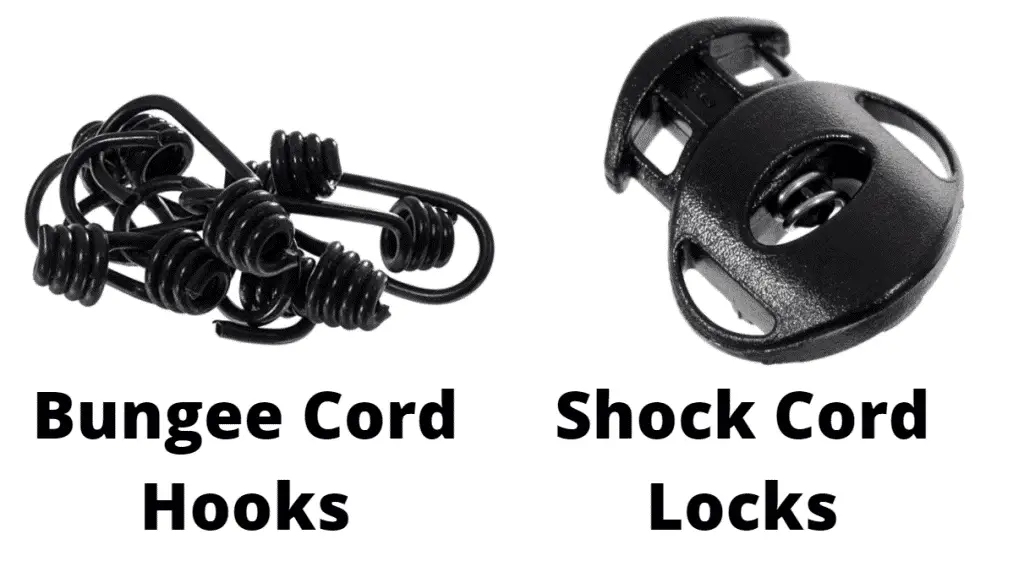Shock cord and bungee cord looks like it’s the same product, but they’re market towards different buyers. Is there really a difference between shock cord and bungee cord?
Is shock cord the same as bungee cord? Yes, bungee cord and shock cord are the same thing. They’re both made out of thin elastic strings bound together in a nylon sleeve. Make sure you check the cord length, thickness, and ends before making a purchase.
Shock cord and bungee cord are basically the same product, but that doesn’t mean you’re getting the same product. You will end up frustrated when the elastic inevitably dry rots, loses elasticity and breaks.
Don’t waste your money on the cheap dollar store bungee cords. The following article will explain how I make my own heavy duty bungee cords.
The Main Difference Between Shock Cord and Bungee Cord
Bungee cord has lots of different names. It can be called bungee rope, bungee cord, stretch cord, stretch rope, bunge, bungie, bungee, bungy, elastic cord, elastic rope, shock cord, shock rope, elasticated rope and elasticated cord.
You have all those different names for essentially the same product. It’s just an elasticized cord made from natural or synthetic strands of rubber covered with a nylon/cotton fabric sheath. The strength of the cord depends entirely on its thickness(thicker=stronger).
Bungee cords can be found in virtually every hardware store. They usually come in short 1-2 ft length multi-packs with pre-installed ends. Unfortunately one size fits all doesn’t work in every application. The cords are either too weak or short.
You could link a few bungee cords together, but that setup looks terrible and won’t last. When you need longer runs you’re better off purchasing a spool of shock cord.
Shock cord comes in spools ranging from 10ft-1000ft. Don’t waste your money on cheap bungee cords. Make your own high-quality bungee cords at a fraction of the cost.
I’ve been purchasing shock cord from Paracord Planets Amazon Store for the last couple of years. They have every size and color that you could possibly need. The 1/8th inch shock cord is the most popular size, but 1/4″ would be better for kayaks and other heavy duty jobs.
Using Shock Cord Instead of Bungee Cords

There are 2 main ways people use shock cords. You can either cut your cord to length and install bungee cord hooks or install metal/plastic cord locks. Refer to the picture above if you don’t know what I’m talking about.
It doesn’t matter which style you decide to use, they’re both self explanatory. Just run the cord through your cord lock and set it up however you’d like.
Installing your own bungee cord hooks will be pretty use. Just run the shock cord through the center of your hook and install 1/2″ hog rings to hold them down. Dewalt sells a tool that makes installing hog rings easy, but you can also use pliers to squeeze them together.
What Size Shock Cord Should I Buy?
It’s hard to say for sure what size shock cord you should buy. I’ve found that 99% of applications call for either 1/8″, 3/16″, or 1/4″ shock cord. Larger sizes would only be needed for safety purposes or heavy duty applications.
I usually purchase Paracord Planets 1/8″ inch shock cord. Their spools are cheap and come in a wide variety of color options. The 1/4″ shock cord is mainly used for my truck and boat tie downs. It’s perfect in my kayak and for holding a tarp down on the bed of my dump truck.
Dry Rot and Elasticity
It doesn’t matter what type of shock cord you buy. The interior rubber strands will eventually dry rot and stretch losing its elasticity.
Keeping your cords dry, indoors and out of direct sunlight will extend their life, but they will eventually rot. Spend the extra money on a long spool of high-quality shock cord and replace the lines every couple of years. I guarantee you’ll find hundreds of random uses after buying a 100+ft spool.



